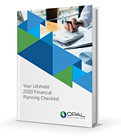5 Strategies to Minimize Taxes in Retirement
By Jesse Giordano, CFP® | December 18, 2019After working for decades, retirement is about transitioning away from the daily grind and taking some much-deserved time for yourself. If you planned ahead and began contributing to your nest egg early on, you’ll have funds waiting for you at the finish line.
But depending on the types of investment accounts you have, that money may not be entirely yours—you’ll have to pay taxes on it if you haven’t already done so. Accounting for taxes can trip up your finances in retirement if you aren’t prepared. Thankfully, there are ways to minimize these costs. Here’s how.

1. Understand Your Required Minimum Distributions (RMDs)
While some retirement accounts are funded with after-tax dollars, the following accounts are not:
- 401(k)s and 403(b)s
- Traditional IRAs
- SEP IRAs
- SIMPLE IRAs
In other words, that money has not been taxed yet. So when you withdraw money from these funds during retirement, you can expect a tax bill—and the bigger the distribution, the bigger the tax burden.
Retirees are required to withdraw a certain amount every year once they turn 70 ½. This amount, also known as the Required Minimum Distribution (RMD), varies from account to account. It’s a rule that makes sense as it prevents people from simply parking their money in retirement accounts to get out of paying taxes. However, with RMDs, your tax liability may actually increase in retirement, which can come as a shock if you aren’t expecting it.
The importance of faithfully taking your RMDs by December 31steach year can’t be overstated. You can absolutely withdraw more than this amount if you need to, but failing to take at least the required minimum distribution will cost you—the IRS will slap you with a 50 percent penalty for your underpayment. So if the tax on your RMD should have been $8,000, you’ll have to pay an additional $4,000.
Another way to reduce your tax burden is to calculate your RMD accurately. (This handy IRS worksheet can help you determine your RMD for each account.) If you calculate it wrong and underpay, you’ll still be penalized for 50 percent of whatever you still owe.
2. Leverage Roth IRAs
If you’re still a ways out from retirement, consider tweaking your plan so that you’re contributing more to a Roth IRA. It’s a wise strategy because it’s funded with after-tax dollars, so you won’t be hit with taxes when you tap this fund in retirement. It’s a win-win.
You can kick in up to $6,000 to your traditional and Roth IRAs combined in both 2019 and 2020; $7,000 if you’re 50 or older. However, there are income thresholds to consider. The higher your income, the less you’re able to contribute. (Here are the official IRS income caps.)
3. Maximize Health Savings Accounts
Health Savings Accounts (HSAs) come with a triple tax advantage. Contributions are tax deductible and also grow tax-free. And similar to a Roth IRA, you won’t be taxed on your distributions or face a 20 percent penalty if they’re used for qualified health care expenses. So how does that figure into retirement? Once you turn 65, you can use these funds for whatever you like; not just medical expenses. You will be taxed on the funds you remove, but you’ll avoid the 20% penalty.
Having this pool of money available in retirement can greatly reduce your tax burden. For 2019, individuals can contribute up to $3,500 to an HSA; $7,000 for families. In 2020, those limits increase to $3,550 and $7,100 respectively. Those who are over 55 can throw in an additional $1,000.
4. Tweak Your Cash Flow in Retirement
Another simple way to cut your tax liability is to reduce your living expenses so that you don’t have to withdraw more than your RMD, which will trigger a larger tax bill. This will also stretch your nest egg and make it last longer. Smart budgeting doesn’t have to mean cutting corners to the point that it impacts your quality of life. Instead, it comes down to crafting a reasonable budget that makes sense for your lifestyle. This, in turn, reduces your dependency on your retirement accounts.
Your income in retirement plays an important role, as well. Consider all sources of income, including any pensions and Social Security. The latter is particularly important—the longer you defer collecting Social Security, the more you’ll receive. Those who can put it off until reaching full retirement age will have better cash flow in retirement.
5. Manage Your Withdrawals Wisely
One other vital detail has to do with managing withdrawals. The focus always comes down to finding a distribution strategy that will minimize total taxes and, as a result, maximize after-tax income over your lifetime—not just in a specific year.
If, for instance, you cash out your Roth IRA during your first year of retirement, you’ll have no taxes for that year. That’s always a welcomed treat, but we encourage you to look at the big picture. If you’ll now be relying heavily on 401(k) distributions and money from a traditional IRA, you can expect a heavy tax bill going forward.
To put it another way, income and cash flow should be structured so that reducing taxes today doesn’t come at the expense of higher taxes in the future. An optimal retirement income strategy is one that manages various income sources—including Social Security income and pensions—with brokerage assets and bank account balances to provide a steady stream of reliable income throughout your whole retirement.
Reducing your taxes in retirement can be a lot to unpack. The right financial advisor is one who understands your priorities and gets your vision for an ideal retirement. At Opal Wealth Advisors, we can help you not only create an effective retirement income plan, but also financially prepare for your transition into retirement—no matter where you are on the journey.
Be a Smart Investor
Stay up-to-date with industry-leading information and news delivered straight to your inbox.
Get our timely insights delivered to your inbox (Blog)
Please remember that past performance may not be indicative of future results. Different types of investments involve varying degrees of risk, and there can be no assurance that the future performance of any specific investment, investment strategy, or product (including the investments and/or investment strategies recommended or undertaken by Opal Wealth Advisors, LLC [“OWA]), or any non-investment related content, made reference to directly or indirectly in this commentary will be profitable, equal any corresponding indicated historical performance level(s), be suitable for your portfolio or individual situation, or prove successful. Due to various factors, including changing market conditions and/or applicable laws, the content may no longer be reflective of current opinions or positions. Moreover, you should not assume that any discussion or information contained in this commentary serves as the receipt of, or as a substitute for, personalized investment advice from OWA. OWA is neither a law firm, nor a certified public accounting firm, and no portion of the commentary content should be construed as legal or accounting advice. A copy of the OWA’s current written disclosure Brochure discussing our advisory services and fees continues to remain available upon request or at www.opalwealthadvisors.com. Please Remember: If you are a OWA client, please contact OWA, in writing, if there are any changes in your personal/financial situation or investment objectives for the purpose of reviewing/evaluating/revising our previous recommendations and/or services, or if you would like to impose, add, or to modify any reasonable restrictions to our investment advisory services. Unless, and until, you notify us, in writing, to the contrary, we shall continue to provide services as we do currently. Please Also Remember to advise us if you have not been receiving account statements (at least quarterly) from the account custodian.



